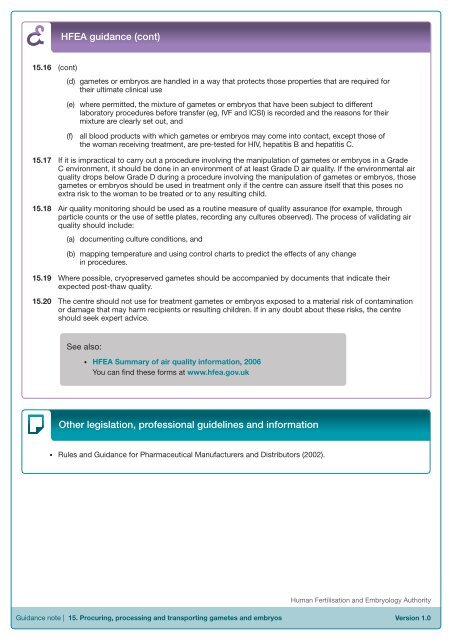Eighth Edition - R.3 - Human Fertilisation & Embryology Authority
Eighth Edition - R.3 - Human Fertilisation & Embryology Authority
Eighth Edition - R.3 - Human Fertilisation & Embryology Authority
You also want an ePaper? Increase the reach of your titles
YUMPU automatically turns print PDFs into web optimized ePapers that Google loves.
HFEA guidance (cont)<br />
15.16 (cont)<br />
(d) gametes or embryos are handled in a way that protects those properties that are required for<br />
their ultimate clinical use<br />
(e)<br />
(f)<br />
where permitted, the mixture of gametes or embryos that have been subject to different<br />
laboratory procedures before transfer (eg, IVF and ICSI) is recorded and the reasons for their<br />
mixture are clearly set out, and<br />
all blood products with which gametes or embryos may come into contact, except those of<br />
the woman receiving treatment, are pre-tested for HIV, hepatitis B and hepatitis C.<br />
15.17 If it is impractical to carry out a procedure involving the manipulation of gametes or embryos in a Grade<br />
C environment, it should be done in an environment of at least Grade D air quality. If the environmental air<br />
quality drops below Grade D during a procedure involving the manipulation of gametes or embryos, those<br />
gametes or embryos should be used in treatment only if the centre can assure itself that this poses no<br />
extra risk to the woman to be treated or to any resulting child.<br />
15.18 Air quality monitoring should be used as a routine measure of quality assurance (for example, through<br />
particle counts or the use of settle plates, recording any cultures observed). The process of validating air<br />
quality should include:<br />
(a)<br />
documenting culture conditions, and<br />
(b)<br />
mapping temperature and using control charts to predict the effects of any change<br />
in procedures.<br />
15.19 Where possible, cryopreserved gametes should be accompanied by documents that indicate their<br />
expected post-thaw quality.<br />
15.20 The centre should not use for treatment gametes or embryos exposed to a material risk of contamination<br />
or damage that may harm recipients or resulting children. If in any doubt about these risks, the centre<br />
should seek expert advice.<br />
See also:<br />
<br />
HFEA Summary of air quality information, 2006<br />
You can find these forms at www.hfea.gov.uk<br />
Other legislation, professional guidelines and information<br />
<br />
Rules and Guidance for Pharmaceutical Manufacturers and Distributors (2002).<br />
<strong>Human</strong> <strong>Fertilisation</strong> and <strong>Embryology</strong> <strong>Authority</strong><br />
Guidance note | 15. Procuring, processing and transporting gametes and embryos<br />
Version 1.0

















